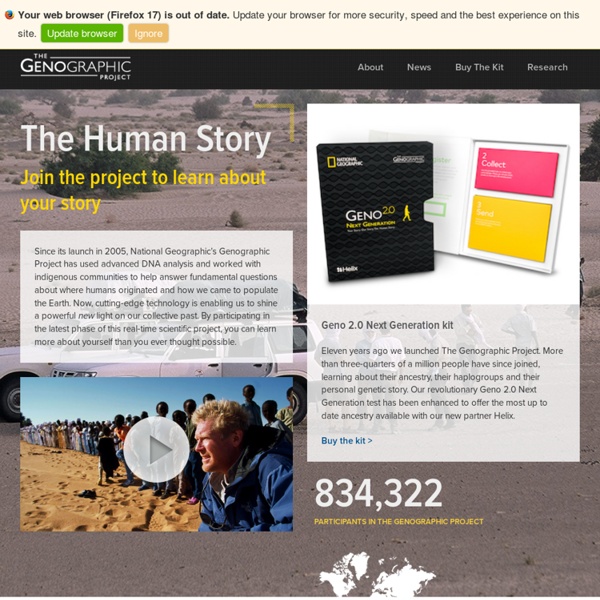



https://genographic.nationalgeographic.com/
Related: PreHistoryWorld's oldest known fossils found in Greenland push evidence for life back by 220 million years - Science News Updated The oldest fossils known to date have been discovered in 3.7 billion-year-old rocks in Greenland by an Australian-led team of researchers. Key points Evidence of ancient bacterial communities known as stromatolites uncovered in rocks in GreenlandDating of rock above and below stromatolites places them between 3.7 and 3.68 billion years oldAnalysis pushes back earliest known evidence of life on Earth by 220 million years Decoded: The Mystery of Human Migration - Science - News Click here to see the graphic 'The maternal journey of OF mitochondrial DNA' Half a million people from around the globe are participating in an ambitious project to reconstruct some of the ancient migratory routes that took Homo sapiens from their ancient African homelands to the relatively new territories of Asia, Europe, Oceania and America. Hidden within the genetic makeup of people alive today is the encoded story of how their ancient ancestors made this epic journey, which covered many thousands of miles over many tens of thousands of years to complete. The Genographic Project, a landmark study into ancient human migrations, aims to decode these hidden signposts within our DNA.
Competition between brain cells spurs memory circuit development Scientists at the University of Michigan Health System have for the first time demonstrated how memory circuits in the brain refine themselves in a living organism through two distinct types of competition between cells. Their results, published today in Neuron, mark a step forward in the search for the causes of neurological disorders associated with abnormal brain circuits, such as Alzheimer’s disease, autism and schizophrenia. “Much of our understanding of the brain’s wiring has come from studying our sensory and motor systems, but far less is understood about the mechanisms that organize neural circuits involved in higher brain functions, like learning and memory,” says senior author Hisashi Umemori, M.D., Ph.D., assistant research professor at U-M’s Molecular and Behavioral Neuroscience Institute and assistant professor of biological chemistry at the U-M Medical School. Brain cells grow and extend along pathways to link different parts of the brain, Umemori explains.
Did early campfires trigger the emergence of tuberculosis? - Science News Posted Fire brought warmth and comfort to early humans but may also have triggered the emergence of deadly tuberculosis, Australian researchers suggest. Key points Tuberculosis first emerged in humans in Africa then spread to animalsMystery about how a benign microorganism became a killerHypothesis suggests fire increased human interaction and smoke made lungs more susceptible to disease Human Journey Everybody loves a good story, and when it's finished, this will be the greatest one ever told. It begins in Africa with a group of hunter-gatherers, perhaps just a few hundred strong. It ends some 200,000 years later with their six and a half billion descendants spread across the Earth, living in peace or at war, believing in a thousand different deities or none at all, their faces aglow in the light of campfires and computer screens.
University of Michigan - Programs of Study, Rackham Graduate School, University of Michigan Home » Academics » Programs of Study Ann Arbor Campus Interdisciplinary Academic Programs Programs at Other Campuses World-first genome study reveals rich history of Aboriginal Australians - Science News By Dani Cooper, additional reporting by Tom Forbes Posted The most comprehensive genomic study of Indigenous Australians to date has revealed modern humans are all descendants of a single wave of migrants who left Africa around 72,000 years ago. Key points Aboriginal and Papuan ancestors left Africa around 72,000 years agoArrived on supercontinent 'Sahul' around 50,000 years agoBy 31,000 years ago, most Aboriginal communities were genetically isolated from each other, giving rise to great genetic diversity
Early Human Migration" No historical record exists that tracks the migratory patterns of the earliest humans. Scientists piece together the story of human migration by examining the tools, art and burial sites they left behind and by tracing genetic patterns. They accomplish this by looking at mitochondrial DNA (mtDNA), which is passed from a mother to her offspring without being blended with the genetic code of the father.
Molecular and Integrative Physiology (PIBS), Rackham Graduate School, University of Michigan Details The Program in Biomedical Sciences at the University of Michigan is an interdisciplinary gateway program that coordinates admissions and the first year of Ph.D. studies for 14 department programs, including Molecular and Integrative Physiology. PIBS offers you the flexibility and convenience of applying to any of our participating programs through one application. Digging deep to discover the first Australians - ABC Kimberley WA - Australian Broadcasting Corporation Two of Australia's eminent archaeologists are back in the Kimberley, trying to unlock the mystery of who lived here thousands and thousands of years ago. Professors Mike Morwood and June Ross are piecing together fragments of information about Australia's first people from archaeological digs and rock art. Professor Morwood helped unearth the pygmy human being on Indonesia's Flores island, which was nicknamed the hobbit and created an international sensation. He says the Kimberley is an important part of Australia's archaeological jigsaw puzzle, because the very first people to arrive here were from Indonesia.
The Human Story: 4. Human migration Home > Biology > Options > The human story > The Human Story: 4. Human migration 9.8 Option - The Human Story: 4. Human migration Extract from Biology Stage 6 Syllabus (Amended October 2002). © Board of Studies, NSW. Prior learning: Recall statements in HSC module 9.3.3.